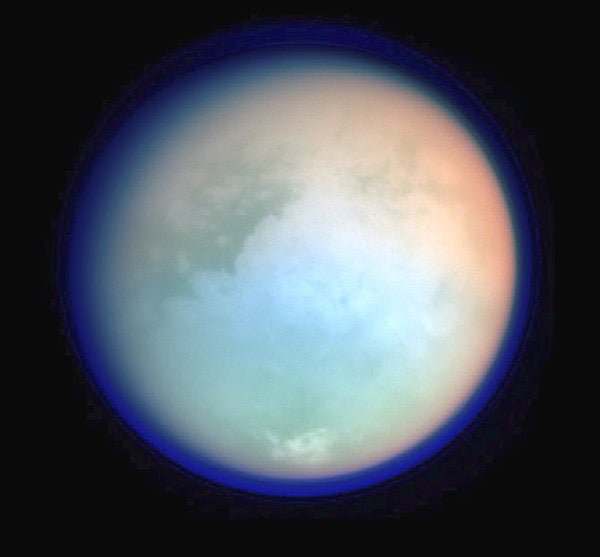
When it comes to worlds for humans to visit, Titan may not naturally jump to the top of any travel agency’s list. This frigid moon of Saturn has an average temperature of –294 degrees Fahrenheit (–181 degrees Celsius). Surface water doesn’t flow — it’s locked away in ice that acts as the world’s crust.
But Titan also has advantages for astronauts looking for a long-term getaway. The world’s thick atmosphere makes it in some ways a moderate environment for human habitats. And its vast hydrocarbon resources make it a potentially lucrative prospect, as well. But more than this, Titan is a prime candidate for scientific exploration, including the potential discovery of extraterrestrial life, which would be even more alien than any found on Mars.
Titan’s Earth-like qualities
Titan is the only other world in the solar system known to harbor liquids at its surface. This is thanks to the fact that it is also the only known moon in this or any planetary system to have a sizable atmosphere. At 4.4 times the density of Earth’s and 1.5 times the atmospheric pressure at the surface, this gaseous layer of nitrogen and methane shields the liquids on its surface. Owing to the cryogenic cold, those liquids are primarily hydrocarbons like ethane and methane. This dense atmosphere also helps to negate the worry, omnipresent on atmospheric deserts like Mars or the Moon, that your blood will boil off if the wall of your habitation unit were to somehow be punctured.
This thick atmosphere also helps block out harmful interstellar cosmic rays — like those emitted by distant supernovas — that threaten astronauts on more barren worlds like Mars. This benefit alone adds significant value to Titan as a potential second home for humanity: It stops cold the runaway train of unwanted genetic damage, which in many ways is a bigger threat to life than the potential harms of living in reduced gravity.
Related: What Titan might smell like | Why Cassini was crashed into Saturn
“For long-term destinations, Mars is just not a very good place,” says planetary scientist Amanda Hendrix, formerly of NASA’s Jet Propulsion Laboratory and currently of the Planetary Science Institute in Tucson, Arizona.
Chief among the challenges Hendrix foresees is that cosmic rays present not only a long-term cancer risk, but a significant danger to human brain matter in the short term. Evidence is mounting that even NASA’s planned short-term research trips to Mars could pose dangerous radiation exposure risks to the astronauts involved. Hendrix argues that Titan is a much more viable option in the long run, since it has a protective atmosphere overhead.
“Going to Mars is a good stepping stone,” says Hendrix. “It’s a good accomplishment to go for. Go to Mars, check it out, and come back.” But, she says, “Titan offers much more opportunity for safe habitation.” She calls it “the most Earth-like place in the solar system.”
A hub of science and industry
Of course, living on Titan long-term presents numerous problems — including how and whether raising children in gravity one-seventh that of Earth’s is possible. But while the solutions may not be clear now, Hendrix thinks they should become apparent as future generations move outward. The tasks required to build a self-sustaining permanent base will give the new titanians plenty to do, but Titan’s thick atmosphere will effectively keep a roof over their heads all by itself.
This will afford the chance to conduct key scientific exploration — including searching for alien life. As Chris McKay of NASA’s Ames Research Center wrote in a 2016 paper on the subject, “The search for life on other worlds is often characterized by the strategy of ‘follow the water.’ Water provides a convenient shorthand for the range of attributes that support life on Earth.” While Titan’s surface water is all locked up in ice, there are indications that liquid water could exist in subsurface pockets, not unlike those on Europa and Enceladus. Even more tantalizing — and speculative — is the possibility of life based not on water but something else, such as ammonia, which would be completely alien compared to life as we know it.
So far, the only explorer to reach Titan’s surface is the European Space Agency’s Huygens probe, which descended through its atmosphere in 2005, returning images and data for about 90 minutes after it touched down. To follow up, NASA plans to launch the Dragonfly rotorcraft in June 2027, which will arrive at Titan in 2034. Taking advantage of the moon’s dense atmosphere, it will be able to fly around to a variety of locations to study how the world’s chemistry evolved over time — and even look for signs of ancient water- or hydrocarbon-based life.
The vast hydrocarbon reserves there mean Titan also has potential as a hub for plastics manufacturing in any future outer solar system economy. Picture, if you will, a not-too-distant future where industries source products from Titan’s lakes and export them to the other gas giant moons and mining settlements springing up throughout the asteroid belt, and you may begin to see what prospective titanians might have to look forward to.
Mars, though closer to Earth, may one day be like Antarctica: a destination for geologists and other scientists to prize out the secrets of its vast, cold deserts, and little else.
Meanwhile, while Titan may appear to be an uninviting desert, it could one day be home to a vibrant and prosperous civilization with culture and industry to match any on Earth.









